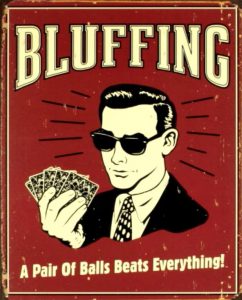Bluffing is, without a doubt, one of the most interesting aspects of poker. Deceiving your opponent by representing better cards than you actually have and thereby making them fold the winning hand can often be very exciting and rewarding. But apart from the rush factor that bluffing provides, it is also a key element if you ever want to be a successful poker player.
If a player would always have to wait until he was dealt the best hand in order to win a pot, poker would not only lose much of its appeal, it would also minimize your profit margin, as every player would become very predictable. Bluffing allows you to mix up your poker strategy and constantly leave your opponents wondering where they stand in a hand. However, the thrill of bluffing always comes with a risk, and if not applied properly, it can get you into a lot of trouble.
Bluffing in poker is an art, and involves a lot more than simply shoving a big stack of chips into the middle to intimidate your opponents and hoping they will lay down their hand. A bluff can’t just be pulled off out of nowhere, but needs to be carefully planned. You need to take into account your opponent, the board cards, the stack sizes, your table image and how the hand was played so far.
When playing against a beginner or a fish that is likely to call every pair and every draw, there is little point in trying to bluff him off a poker hand, seeing as he is very likely to call anyway. Against these kinds of players it makes more sense to play straight up, wait until you hit big and then take them down.
If the flop brings a scary board like A-K-10, chances are one of your opponents has hit a part of that flop, seeing as many players tend to call aces and face-cards preflop. Don’t go broke trying to bluff somebody off a hand when the chance is high your opponent(s) flopped a strong hand.
If the player you’re trying to bluff only has very few chips left in front of him and has already invested a great deal into the pot, he is pretty much forced to call any bet you make. If the pot already contains $ 20 and your opponent only has $ 3 left, there is practically no way he is not going to call your bet, no matter what cards he has in his hand.
Bluffing successfully greatly depends on what the other players at the table think of you. If they’ve already caught you bluffing a couple of times, chances are they’re not going to believe you the next time. If, on the other hand, your table image is very tight and you’ve always shown strong hands on the showdown, your opponents are more likely to give you credit for another strong hand.
Think about what you’re trying to represent with your bluff. If you’ve been showing weakness throughout the entire hand (simply checking and calling every round), don’t expect your opponents to believe that you’re suddenly holding a monster on the river.
As you can see, there are numerous aspects to bluffing in poker, and as with most things in life, the best way to learn is by doing. Just make sure to put some thought into it before putting your well-earned dollars on the line. And don’t worry if the bluff doesn’t always work out. If you never get caught bluffing, you’re probably not bluffing enough.
Here is one of the biggest bluffs in the history of poker, by one of the (if not the) best poker player in the world Phil Ivey:
{youtube, –Qap3VT_ZY}
